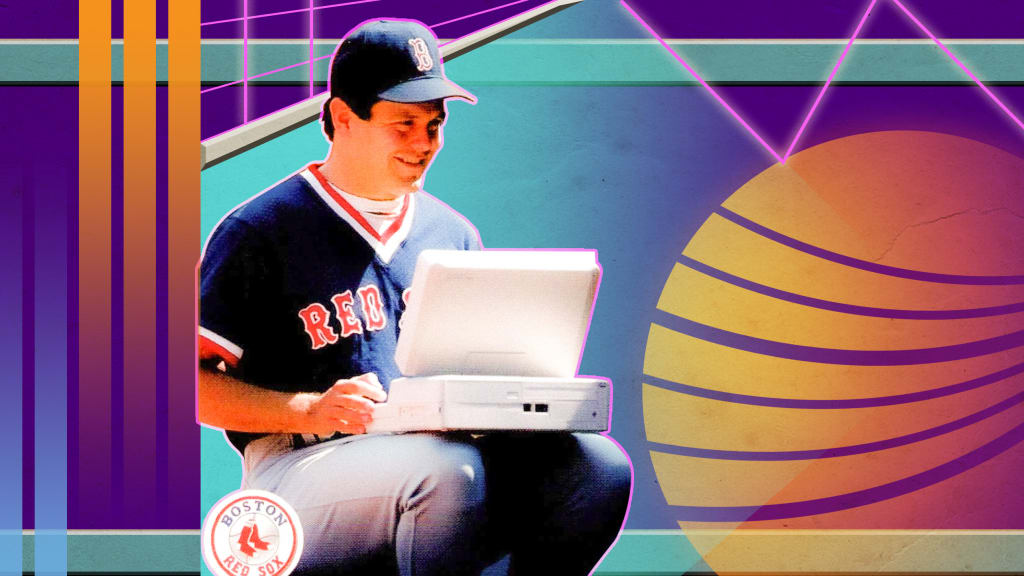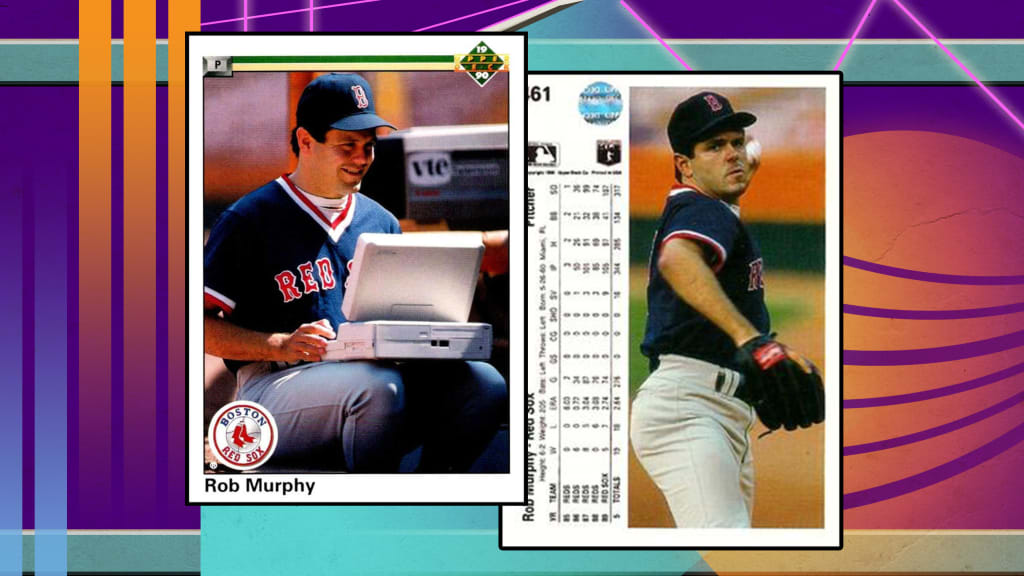
A version of this story was originally published in June 2021.
Great baseball cards have value that captures baseball at its best, stirs your nostalgic soul and perhaps even enriches your bank account. But strange baseball cards have value, too. They bring not just the stats but the laughs, thanks to poor production, confounding composition or unflattering photography. We’ll let the auctioneers and the hobbyists harp on the great cards. Here, we aim to explore the messiness and the mysteriousness of some of the most bizarre baseball cards of all-time.
Player: Rob Murphy
Card: 1990 Upper Deck (#461)
Value: $1.25 on eBay
There he is, relief ace Rob Murphy, looking crisp and fresh in his Boston Red Sox uniform, holding a computer that looks more like a large stone tablet. It's the perfect baseball card for a world where the '90s are in vogue, vaporwave is a popular aesthetic and every baseball player, coach, scout and fan is chained to their computers and smart phones, constantly looking at stats, Rapsodo data, launch angle and more.
The card has carved out its own place in Internet baseball lore, earning Murphy the title of "O.G. Stat Nerd." Oh, how right that is.

That this card exists at all is thanks to two key moments.
1. The class
Credit for the first goes to his mother's friend, who convinced Murphy to enroll in her computer class while in high school in 1978 -- a time when those were far from the norm. He then had to create a program and show off how it worked. Murphy, who comes from a family with a long history in horse racing, decided to handicap the upcoming Kentucky Derby. Using the information that could be found in a racing form, Murphy and his partner input the data -- which got so large they had to enroll in the nearby junior college to use a computer lab that had more storage space.
"How should I grade you?" the teacher asked.
"If our horse wins, we'll get an A. If it runs second, we'll get a B, third we'll get a C," Murphy said in a phone call with MLB.com. "I look back on it and I've got a smile on my face. Man, we could've gotten a Q."
The morning of the race on May 6 also happened to coincide with the district championship baseball game, so Murphy's father got the PA announcer at Mark Light Field in Miami to hold the microphone up to the broadcast of the race so Murphy could hear the whole thing. Affirmed finished first, Alydar in second and Believe It came in third -- exactly what the program recommended.
"So, we got an A," Murphy says with a laugh.
Flash forward a few years and Murphy's in a rut since being drafted by the Cincinnati Reds. He's been stuck in Class A for three straight years and has started wondering if it's time to give up on the dream. Worrying about his future, Murphy thought back to his program, which he had continued to update and improve upon as a computer science major at the University of Miami.
"There's a lot of downtime in Minor League Baseball," Murphy said. "You don't have to get on the bus until five in the afternoon. And if you wake up somewhere before noon, you've got plenty of time to work."
So, that winter, Murphy really buckled down and spent 16 hours a day at his computer. He got the "American Produce Records," which is a full and complete record of American racehorses. Murphy input all 13,000-some pages that were in the book and ran his program. It spit out the name of a horse and, with help from a partner who supplied the funds, Murphy bought it for $30,000.
It won or finished second in seven of his first eight races, earning a total of $77,000. Because Murphy didn't own the horse outright, it ran more often than he'd recommend and ended up getting hurt. But there was something to this program; the proof was there.
Murphy still had a baseball career, though -- one that was just about to take off. Soon, he was pitching in the Major Leagues for the Cincinnati Reds as their bullpen stopper. After appearing in two games in 1985, he posted a 0.72 ERA in '86 -- a record for the lowest ERA by an NL reliever with at least 50 innings that still stands today. He pitched in an incredible 163 games over the next two years for Cincinnati.
"The thing that I liked doing best was stranding baserunners, because that was my teammates," Murphy said. "I wanted to come in and high-five those guys, like, 'I'm looking out for you.'"
Then came the photoshoot.
2. The magazine
In 1990, Murphy -- then with the Red Sox -- had become renowned for his work on the PC. He adopted one of the earliest personal digital assistants on the market, kept it in his jacket pocket in the bullpen and used it to input information on every batter he faced. It may seem simple now when players have tablets with video footage of every plate appearance available in the dugout, but this was pretty much unheard of for a Major Leaguer at the time.
"I was able to track the hitter, the team, left, right or switch," Murphy said. "And I was able to put all the at-bats in -- whether it was a key situation or not, the first pitch -- if they swing or not -- what the first pitch was, what the action pitch was, what the result was and how I felt that day. Because some days a guy would get a hit off me, and let's say my fastball felt like a seven on a one-to-10 [scale], well, if I'm out there two nights later, and I feel like a 10, I'm not afraid to use my fastball."
That got the attention of an editor at the now-defunct "PC Laptop Computers Magazine," who wanted to do a feature on Murphy as one of their "Laptop People." So when the Red Sox were in Anaheim to play the Angels -- near the magazine's Los Angeles offices -- he arranged to do the interview. Even better, with the upcoming publicity, he was able to get a new-fangled laptop he had his eyes on for free.
"It had eight color grayscale screen, had a processor that was like 4.75 hertz -- it wasn't megahertz or gigahertz," Murphy says with a laugh. "And you had 20 megabytes, or maybe it was 40 megabytes of hard-disk space. $5,000 machine, right? That's what those things cost back in the day. Did I tell you it weighed 20 pounds? Oh my god, it was like lugging around a gold brick."
While Murphy was playing with his new $5,000 toy, there happened to be an Upper Deck photographer working, too.
"So, here I am getting pictures with this magazine photographer," Murphy said, "and [the Upper Deck photographer] snapped that shot, and there it was. I didn't know that Upper Deck had taken pictures. I didn't know they were gonna do that."
After retiring from baseball in 1995 and later helping his daughter secure a softball scholarship, Murphy is still using that software with his company, M375 Thoroughbreds, to help purchase stake-winning horses at a rate far beyond the normal success chance in horseracing. It's basically "Moneyball" for the horse track. It's not a bad life for what started on a whim nearly 40 years ago and was considered his backup career while in the Minor Leagues.
And how does he feel about his status as a cult baseball card hero, one whose image still gets passed around by incredulous baseball fans every year?
"When it came out that year, I'm like, 'I love it!' Murphy said. "This is my favorite card!"
Michael Clair writes for MLB.com. He spends a lot of time thinking about walk-up music and believes stirrup socks are an integral part of every formal outfit.
